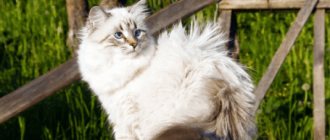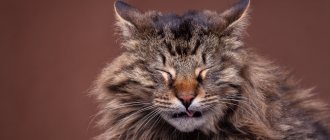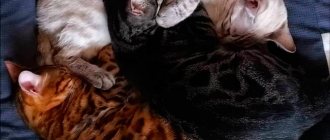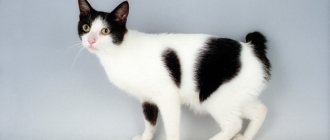History of the Siamese cat breed
Siamese cat
Documentary evidence of the existence of a particular breed cannot always accurately indicate its age, because after the advent of writing, the first chronicles were written on fragile natural materials: tree bark, papyrus, palm leaves. Of course, over time, such scrolls were destroyed.
Sometimes they managed to make “lists” from them, that is, manually created copies, to which changes and additions were often made. Therefore, it is difficult to say exactly when the original scientific treatise “Tamra Maew” was written - a poetic description of various cats that lived in the territory of modern Thailand. According to hypotheses, this happened during the existence of the Kingdom of Ayutthaya (Ayutthaya), that is, between 1351 and 1767. However, the surviving copies of the poem, which are in the royal Buddhist temple Wat Bowon in Bangkok and the British Library in London, date back to the mid-19th century.
Be that as it may, on sheets of ancient paper made from the bark of a Thai variety of mulberry tree, 23 cats of different breeds are depicted. Six of them, according to the author, bring misfortune to a person, and the rest help to attract good luck. Among the latter, Wichienmaat stands out - a proportionally built white cat with dark hair on its face, ears, paws and tail.
For a long time, these animals were considered sacred; they lived in the temples of Siam (as Thailand was called until the middle of the last century) and at the court of local monarchs. Possession of them by mere mortals, much less taking them out of the country, was strictly prohibited. The Western world learned about the existence of Siamese cats only towards the end of the 19th century.
Siamese kitten
In 1872, at the famous London exhibition hall Crystal Palace, an unusual cat from Central Asia was presented to the public. The reaction of specialists and ordinary people was ambiguous; there was even a journalist who awarded the overseas guest the epithet “nightmare.” However, many breeders were not so much afraid as they were intrigued by Dorothy Neville’s favorite. However, due to problems with exports, there was no talk of developing the breed. Only in 1884, the British Ambassador Owen Gold brought a promising couple to Foggy Albion for his sister: a neat cat with rounded outlines, Mia, and a slender, elongated body kitten, Fo. Just a year later, one of their heirs became champion. Soon the first European standard was approved, a club for breed lovers was created, and selection work began.
A little earlier, in 1878, US consulate employee David Sickels made a gift to the presidential couple, Rutherford and Lucy Hayes. The fact that the Siamese kitten was sent to America by ship is evidenced by a cover letter from a diplomat, which is kept in the archives of the Hayes Presidential Center in Fremont, Ohio. Just two decades later, oriental cats became very popular in the New World.
Among the famous owners of “moon diamonds” (as Siamese are called in their homeland), one can recall another American president, Jimmy Carter, the founder of Pink Floyd, Syd Barrett, writer Anthony Burgess, winner of two Oscars Vivien Leigh, British Prime Minister Harold Wilson, legendary musician John Lennon, actor Gary Oldman and others.
Siamese cat in motion
Taking sunbathing
History of the origin of the breed
It is believed that the birthplace of the first Siamese cats is Asia. The country of origin of Siamese cats is Thailand, which several centuries ago was called Siam.
Siamese cats served as temple guards and accompanied those who died to the world of the dead. That is why these animals are still considered sacred in Thailand.
After the Siamese received special favor from the local residents, various works began to be dedicated to them. Thus, in the National Library of the country there is a well-known work “Treatise on Cats”, which talks about these sacred animals.
Several centuries ago, the Thais decided to create a special society to protect Siamese cats from extinction.
And in 1870, Queen Victoria of England received as a gift one of the representatives of this breed, which within two years the owner liked so much that she brought her favorite with a purebred Siamese Pudles to continue the family line.
This is interesting! Despite the fact that the Siamese cat first appeared in England in 1870, full breeding of this breed began only two decades later, with the advent of the Siamese Cat Club in 1901.
8 years later, the first Siamese cats appeared in the USA. But 40 years later it was necessary to revive this breed again, since there were practically no representatives of it left. This is due to military operations in the country. Updated standards for the Siamese cat were only published in 1966.
Starting in the 60s, the Siamese cat was finally brought to the Soviet Union. The first Siamese appeared in wealthy Moscow families and among the intelligentsia.
Appearance of a Siamese cat
As mentioned above, there are significant differences in breed standards. Most associations believe that the Siamese cat should have a slender but muscular body with elongated lines, and cats with smoother and more rounded features are classified as the Thai breed (or they are called traditional Siamese cats). Siamese cats are small in size, weighing from 2.5 to 6 kilograms.
Head
Wedge-shaped, long and tapering from the narrow point of the nose to the tips of the ears, forming a triangle.
Ears
The ears of Siamese cats are unusually large, wide at the base, pointed at the end, repeating the same triangular shape as the head.
Eyes
Medium size, almond-shaped, somewhat obliquely set. Always have a deep bright blue color.
Siamese cat face
Body
Elongated, flexible, muscular.
Limbs
Long and thin, the rear ones are higher than the front ones. The paws are small, graceful, oval in shape.
Tail
The tail of Siamese cats is long and thin, tapering towards the tip.
Wool
Short, fine texture.
Siamese cat teeth
The eyes of Siamese cats are always a rich, bright blue color.
Color
The Cat Fanciers Association allows four colors of Siamese:
Siamese cat at an exhibition
- seal point, pale yellow to cream with contrasting brown spots on the feet, tail, ears, face, brown nose and paw pads;
- chocolate point, an ivory base with milk chocolate spots, brown-pink nose and paw pads;
- blue point, bluish-white body with gray-blue spots, slate gray nose and paw pads;
- lilac point, white body with pink-brown spots, lavender-pink nose and paw pads.
The International Cat Association considers a normative range beyond the four color-point colors recognized by the CFA. It includes the Pointed Tabby, the Red Pointer, the Cream Pointer, and the Pointer with Tortoiseshell markings.
Characteristic external features of a Siamese cat (differences from the Thai breed)
Refined, lean physique.
A special mindset.
Bright look.
Smooth silky coat.
Pointy ears.
Wayward character.
Many people confuse Siamese cats with their close relatives - representatives of the Thai breed. But there are significant differences between these cats, both in behavioral characteristics and in external features.
- Thai cats have a round body, while Siamese cats have a more refined, lean and graceful build . Adult animals weigh three to four kilograms .
- Siamese beauties have triple and muscular paws with rounded pads .
- The animals' tail is thin and long with a sharp tip, which makes it resemble a whip.
- Cats have an elongated head with a straight, long nose and pointed, pronounced cheekbones.
- Thai cats have small round ears, while Siamese cats have large, wide ears with sharp tips .
- The bright, almond-shaped eyes of Siamese cats immediately attract attention. Eye color is turquoise blue, sometimes with a violet tint.
- The animals' fur is short, soft and silky.
- Siamese cats can have any color from golden cream to smoky blue. But, regardless of the color of the fur coat, the tail, tips of the paws, ears and muzzle should be painted in a darker, more saturated color.
The uniqueness of Siamese cats also lies in the fact that representatives of other breeds have never been used for their breeding , thanks to which it was possible to preserve the original appearance and characteristic features inherent in these amazing animals.
Photos of Siamese cats
Siamese cat: character and reviews
There are many myths regarding this breed, which is why people’s attitudes towards animals are ambiguous. For example, there is an opinion that the Siamese can harm its owners. This is not entirely true. To avoid such a situation, it is necessary to properly care for the animal and establish contact with it. Cats should not feel a lack of attention on your part. Then you will be able to win his trust, love and even devotion. It is worth remembering that the Siamese cat (photos are given in the article) is very jealous. She will never accept another animal. But when it comes to children, cats are more loyal. However, animals do not like chaos in the house and screaming, so you need to think carefully before getting such a pet.
In general, the character of a cat can be described as unpredictable. The animal exists on its own and chooses its owner. And if she didn’t like you for some reason, and she disliked you, that’s forever. Cats have a very good memory. They remember the insult and unfair punishment for a long time. Families with children should refrain from having such a pet, because all children love to carry and hug animals. But the Siamese do not understand such treatment. Of course, they rarely show aggression towards children, but you can’t escape nature. It is necessary that the child treats the pet with respect and care, then the Siamese will reciprocate. But this is not always possible, especially when it comes to kids.
Siamese are very playful, so it is necessary to hide all valuables with them, as they will be used. It is important for cats to communicate a lot; they are incredibly sociable. Animals are easy to train and are quite capable of learning a couple of commands. From a young age, cats should be taught hygiene procedures and training. Siamese are smart beyond their age. They quickly become toilet trained. You need to be very careful with pets such as birds and hamsters. After all, cats are hunters by nature, so such proximity to Siamese is extremely dangerous.
As for the reviews and the breed, they are quite different. Still, each animal has its own character. Siamese do not show aggression, but are very demanding creatures. They may go on strike and not eat if they don't like the dish. Moreover, the animal, by virtue of its nature, strives to achieve what it wants. The temperament of the Siamese cat (Thailand) is not the simplest.
Character of Siamese cats
Siamese cats skillfully use their vocal cords, easily change the tonality and pitch of sound to express feelings.
There is an opinion that all Siamese cats have an unbalanced character, are touchy, vengeful and simply aggressive. Breeders who have been working with the breed for many years are confident that such words are unfair. Yes, these are quite capricious and demanding pets, so they should not be owned by people who dream of an easygoing companion who will behave as quietly as possible.
For Siamese, communication is as vital a necessity as food and water. And it’s not just about playing together and affection! They literally talk to the owner, using a loud voice and expressive intonations, reporting everything they like or don’t like, are interested in, worry about, or irritate. After being separated for several hours, a detailed “report” about what happened during the day will be waiting for you, and your pet, of course, expects a response to his tirades; he will be happy to support the conversation.
By the way, Siamese cats are very sensitive to emotions expressed in human speech, they are offended by an angry, rude tone, so do not raise your voice unless necessary - it has long been proven that animals can also experience depression, which leads to negative consequences for physical health.
Siamese cats are attached to their family members, do not like loneliness, and will readily accompany you while moving around the apartment and “help” with household chores. And when you finally settle down in a chair with a laptop or a book, they will gently snuggle against your warm side and purr with pleasure.
Impressionable royals are not so patient as to constantly communicate with children under the age of 6-7 years, who do not understand the boundaries of personal space and, in their delight at the sight of a beautiful “kitty,” forget that a living creature cannot be treated as unceremoniously as a plush one. a toy. Siamese cats treat older children quite well.
As for other pets, no one can guarantee you peace and harmony in the house, although some Siamese make friends with dogs. If one pet is not enough for owners or they want to protect their furry family members from loneliness while everyone is at work, the best option would be to simultaneously purchase two Siamese kittens.
The Siamese cat is quite jealous, therefore, if the owner has a desire to have another pet, he needs to think through everything clearly and consult with a specialist. By the way, such cats are wary of strangers.
Because cats love freedom, they feel quite normal if they have to stay home alone for a long time. But when the owner returns, he should communicate with his pet - representatives of the breed love to play.
Raising a Siamese cat
A kitten must be raised from the first days of its appearance in the house. If you don’t want to rack your brains over how to stop him from scratching or relieving himself in the wrong place, then immediately stop all prohibited actions. Use standard prohibition commands: “fu” and “no”. The first is used for a permanent ban, the second for a temporary one. For example, “fu” can be used to discourage walking on the dinner table, and “no” can be used to prohibit scratching after sterilization.
Education should be based on affection and respect. Vengeful and aggressive animals are the result of abuse. The main tool of influence is intonation. It is well captured not only by adult animals, but also by kittens.
Siamese are clean, so they are easy to toilet train. Be persistent during training. Do not give up ahead of time, otherwise the pet will understand this and will create the appearance of misunderstanding with your commands.
Care and maintenance
It's time for someone to go on a diet
Preferably kept at home with short walks under human supervision. These sophisticated creatures have lived in warm tropical climates for centuries, so they do not have the cold tolerance that their Norwegian or Siberian counterparts boast.
At the same time as the kitten, the house should have a permanent place for feeding, a calm and comfortable corner for the toilet with a suitable tray, toys designed to train not only muscles, but also the intellect. It is advisable to buy a cat tree house so that your Siamese can feel like a brave conqueror of peaks and look down on everyone a little.
The structural features of the short, smooth coat make caring for Siamese cats as simple and tireless as possible. Frequent bathing is contraindicated, since the lack of a natural fat barrier impairs the immune system. Cats are very clean and keep themselves in good shape. It is enough to go over the entire “fur coat” once or twice a week with a special comb-comb – and your pet will look 100% perfect. Of course, provided that he is provided with proper nutrition.
The easiest way to organize a complete diet for animals of any age is with ready-made premium and super-premium food. In this case, constant access to fresh water is especially important.
To avoid problems with the oral cavity, regular brushing with pet toothpaste and a special brush that fits on the owner’s finger is recommended. Preventive examinations in a good veterinary clinic are designed to prevent the development of other ailments.
Care
Pets' hair is short and smooth, they do not need to be constantly combed, once or twice a week is enough. You can feed them both natural food and premium dry food. A nail sharpener will come in handy to avoid scratches on the furniture.
You can walk outside with a furry family member only after all vaccinations and preferably with a leash - he can become infected with anything from any stray animal. His immunity is low, the virus can be very dangerous.
In principle, no special problems arise when keeping these cats, except perhaps with bathing. They are terrified of water and become stressed when taking a bath. As a rule, they manage to keep their fur clean on their own, but if they are very dirty, you can bathe them with a special shampoo, you just need two people - one to hold them and the other to wash them. Do not use a hair dryer after this - it can dry out the skin and fur. Let it dry naturally, just make sure there are no drafts in the house and first wrap the wet lump in a terry towel.
Babies should be fed four times a day if they are not yet six months old. After this, three meals will be enough. And when they are one and a half years old, food will need to be given twice a day.
Typically, Siamese do not overeat, they are able to control the amount of food themselves, but it is still better to focus on the norms, which depend on weight and age (usually they are indicated on the food box). In case of illness, contact your veterinarian immediately; any delay can be dangerous.
Health and diseases of the Siamese cat
Like other purebred animals, Siamese cats are prone to developing certain diseases.
- Amyloidosis is a pathological accumulation of protein in the kidneys, liver or pancreas, which leads to dysfunction of these organs, including their failure. It occurs much less frequently than in Abyssinian cats, but it is worth remembering this risk, because a currently incurable disease, if detected at an early stage, can be significantly slowed down.
- Asthma and other bronchial diseases.
- Congenital defects of the cardiovascular system, such as aortic stenosis or distension of the heart chambers (dilated cardiomyopathy).
But in general, Siamese are healthy animals, their average life expectancy is 11-15 years, and there are also long-livers.
Health of the Siamese cat
The breed is long-lived. The maximum lifespan of these animals is 20 years. However, the Siamese cat's health can be precarious if its diet is not monitored.
For your pet’s health, do not forget about parasite treatment and vaccinations. Deworming is carried out quarterly, and vaccination is carried out annually. There is a separate vaccination schedule for kittens. From 2-3 months to 1 year, vaccinations are given gradually with mandatory revaccination. After 1 year, animals are administered only polyvalent vaccines containing several viruses simultaneously. They provide immunity against the most common viral diseases.
Possible diseases
It is impossible to protect your pet from all diseases, so do not forget about preventive examinations with a veterinarian. The following diseases are common among representatives of the Siamese breed:
- Bronchial asthma
. If your cat is bothered by frequent and prolonged coughing attacks, get examined. Asthma is often caused by allergens: tobacco, household chemicals, house dust. If the situation is left to chance, the cough can develop into suffocation or respiratory failure. The pet may die. Determining the exact cause of asthma is almost impossible. If there are no pathological changes on the x-ray, the doctor prescribes antihistamine tablets. If the symptoms disappear, the diagnosis is confirmed. For frequent attacks, veterinarians recommend purchasing a cat inhaler.
- Amyloidosis
. When protein metabolism is disrupted, excessive amounts of abnormal proteins accumulate in the liver, kidneys or pancreas. They trigger an autoimmune process - the rejection of their own cells with subsequent destruction of the affected organs. There is no cure for the disease, but it can be slowed down with early diagnosis.
- Pathologies of the cardiovascular system
. This group includes aortic stenosis, accompanied by a decrease in blood supply to the heart. Animals with this disease are culled from breeding. Treatment depends on the severity of the pathology. If the quality of life is not threatened, then it is enough to protect the pet from intense physical activity.
Obesity and joint diseases often avoid Siamese, but this does not mean that the cat can be overfed.
Reproductive health
The first heat in Siamese occurs at 5-9 months, but mating is allowed no earlier than the third heat. With earlier fertilization, the cat is not able to bear healthy kittens. Pregnancy lasts from 55 to 65 days. Vitamins prescribed by a veterinarian must be added to the diet of a pregnant pet. They contribute to the proper formation of embryos and strengthen the mother’s immune system.
Siamese cats give birth to from 4 to 8 kittens, and some record holders give birth to offspring numbering 13 babies. Primiparous females often suffer from a lack of milk. The problem can be solved by injections of medications, but they can only be done after examination by a veterinarian. Dosages calculated independently can harm the animal.
If you are not ready to give birth, sterilize your animals. Spaying and neutering are recommended for all cats not involved in breeding. The optimal age for surgery is 6-8 months. Younger age is fraught with obesity and pathologies of the genitourinary system. Older pets are more difficult to tolerate anesthesia, so surgery is performed only as a last resort.
How to choose a kitten
Sleepy kingdom
In the case of Siamese cats, the advice common to all purebred animals is relevant: you can only trust well-established nurseries and breeders whose reputation is impeccable. In such conditions, we can talk not only about guaranteeing the purity of the breed, but also about concern for obtaining genetically healthy offspring.
It should be remembered that kittens are born with a uniform light coat, and acquire “signature” dark spots as they grow up. Meeting the parents can give you a rough idea of what the baby will look like in a few years.
The main guidelines should be personal sympathy and the health of the future pet. Suspicions are caused by apathy, poor appetite, bloated stomach, mucous discharge from the eyes or nose, and reluctance to make contact with a person.
Important indicators are not only the presence of a pedigree and age-appropriate vaccinations, but also decent living conditions for mothers and kittens: a spacious, clean room with soft bedding that protects from the cold, and a sufficient number of toys that promote harmonious development.
History of the origin of Siamese cats
The homeland of Siamese cats is Thailand. Previously, in this country they were considered sacred; cats were highly revered in temples and protected by law. In the king's family, these animals were used to perform certain rituals. For all these reasons, the export of Siamese cats outside the country was prohibited. But some time passed, and she still found herself in Europe.
Mention of the Siamese cat can be found in ancient Thai legends and myths. For example, one of them says that a cat belonging to this breed always went with the princess to the river. Before going into the water, a person of royal blood took off all her rings and bracelets, after which she hung them on her cat’s tail, instructing the pet to protect the jewelry until the owner returned. One day it happened that the cat lost her ring, and from then on the princess began tying knots on the cat's tail.
Knots are also part of the story. Previously, people believed that the presence of kinks and knots on a cat's tail was a characteristic feature of the Siamese. Nowadays, it is known that the occurrence of such a defect was a consequence of the crossing of related individuals. Today, if a Siamese cat has knots and creases in its tail, this is considered an unpleasant defect.
Even in our time, it is not known exactly where the cats belonging to this breed came from. There is an assumption that they originated from animals of the Bengal breed. This can be proven by using the fact that both Siamese and wild Bengals have a gestation period of at least sixty-five days. This distinguishes them from other cat breeds, which carry kittens for between fifty-five and sixty-five days.
In European countries, this breed became widespread only at the end of the nineteenth century, when the consul from Great Britain brought the first Siamese cats to the country, which were a gift from the Thai King of Siam. In the USA and other countries, these wonderful pets appeared later. Today there are about forty species of Siamese cats, among them there are also monotonous individuals (cream, lilac, and so on).
Photos of Siamese kittens
Maintenance and care
Some features of the animal’s character are more than compensated for by simple care for it. Siamese cats need to comb their fur weekly, after which the coat is smoothed with wet hands. It is recommended to bathe Siamese in the most extreme cases, since they are incredibly afraid of water.
It is imperative to perform oral hygiene procedures. Teeth should be brushed regularly and your pet should be shown to the dentist. The ears, like any cat, need to be cleaned with slightly damp cotton swabs. Perhaps this is where all the procedures end. Otherwise, the animal can take care of itself. Many Siamese go to the toilet. If your pet is litter box trained, it must always be kept clean. The cat's bowl should also always be clean. Animals of this breed are distinguished by cleanliness, so they do not tolerate dirt. It is also worth purchasing a special scratching post so that the Siamese can regularly grind off his claws himself. Otherwise, you will have to trim them regularly (once every two weeks). The animal's ears and eyes should always be clean. If they become very dirty often, you should seek help from a veterinarian. After all, some ailments can manifest themselves in this way. From a young age, the animal must be accustomed to solid food, which will help the bite to form correctly.
How much does a Siamese cat cost?
The price of a Siamese kitten largely depends on the success of its parents at exhibitions, color, and individual characteristics (compliance with the breed standard).
The city and the eminence of the nursery are also of some importance. On average, for a kitten that can become a pet, but does not claim championship titles, they ask from 6 to 25 thousand rubles. A future exhibition participant will cost the owners at least 27-35 thousand rubles. The cost of a kitten that is bought “for breeding” starts from 50 thousand rubles.
Character of Siamese cats
Siamese cats are one of the most intelligent and also curious felines. These animals have a rather unpredictable temperament, they can even be jealous. Siamese cats like to be constantly close to their owner, so they always follow him everywhere. Such pets are quite easy to train, and if you are patient, you can even teach your pet various tricks.
Siamese cats are quite loyal and affectionate and love to play. They simply need constant human attention, so if you cannot stay near your pet for a sufficiently large amount of time, it is better to forget about Siamese cats. This recommendation also applies to those who like the house to always be quiet and calm, because these animals are simply overflowing with energy. Some of those people who have Siamese in their homes say that their habits are more like dogs.
https://youtu.be/nq1fQlPpsIg
Siamese also like to talk to their owner, so if you don’t like frequent and loud meowing, again, you should take a closer look at other pets. Siamese cats are animals that are definitely not for everyone. However, if you need a gentle pet that attracts attention with its appearance and habits, then representatives of this breed are what you need.
In a family, such pets show their best side, because there are many owners, so each of them will receive the attention of a Siamese cat. If we talk about what kind of relationships an animal can build with other pets, for example, with dogs, then everything depends on the individual characteristics of the cat, including its character.
Color of Siamese cats
The color of Siamese cats attracted people's attention back in the 16th century. A beautiful dark mask and stockings on graceful paws brought these animals great popularity.
Many have noticed that this characteristic color does not appear immediately in newborn kittens. At first, babies have a light fur coat, only smoky spots are slightly visible on the tips of their ears, tails and muzzles. Only after a few days dark spots begin to appear on them.
Scientists have found out the reason for this unusual coat color. It turns out that the color of the hairs depends on the temperature of parts of the body: in hot areas the hairs will be dark, and in cold areas they will be beige, cream or white. And since the mother cat is warm everywhere in her tummy, the kittens are born very light.
You can buy a kitten directly from the market, according to an advertisement, but in this case there is a possibility of deception. It is best to purchase a Siamese kitten from a nursery. There they will help you with registering your baby, issue you a passport and draw up a pedigree.
Nutrition of Siamese cats
The diet of cats of this breed differs little from the diet of others. Veterinarians recommend regularly feeding Siamese with lean meat (turkey, chicken, beef), just scald it with boiling water first.
You should not give your cat too much fish, a maximum of two servings per week. Fish can cause allergies in animals, and these products also contain little essential protein. It is worth including some dairy products (milk, sour cream) in your diet.
Siamese cats calmly eat commercial food:
- Royal Canin.
- Nutro Choice.
- Iams.
- Purina Pro Plan and others.
It is useful to include dry food with vitamins in the Siamese's diet once a week. Remember to always leave a bowl of fresh water. Siamese cats are very proud oriental beauties who love their owners.
This is interesting - see all the photos of the Balinese cat.











